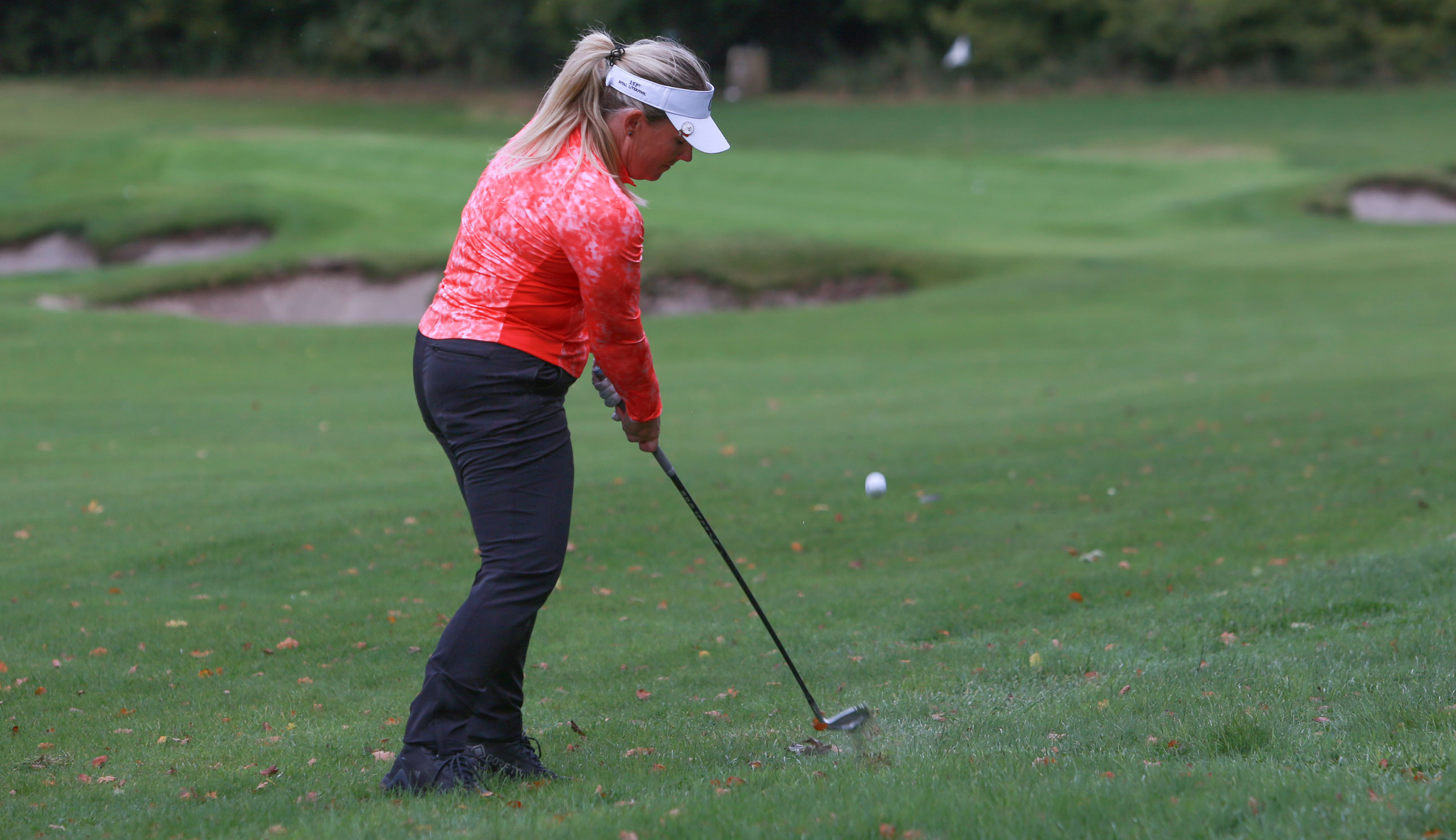What Is The Correct Gapping In Golf?
Get the right distances between your clubs and you’ll be far more accurate, setting up more par and birdie chances. Carly Frost delves into the importance of distance gapping


Most of us have 13 clubs and a putter in our golf bag. The chances are your set make-up is pretty standard, with a selection of wedges, irons and woods, along with maybe one or two hybrids in place of your long irons in the mix. But do your clubs each travel a set distance with an even distance gap between each one? This is the key to scoring and it’s called distance gapping.
Knowing, with reasonable precision, that when struck well, a club will carry a certain distance really is essential to improving your scores. Now I appreciate that mid-to-high handicappers struggle with consistency, especially if you're new to golf and your handicap is coming tumbling down because you are working on your technique, but what I’m talking about here is finding your ‘average’ distance with each club you hit.

How To Find Your Distances
The modern method of finding out how far each of your clubs goes is either by getting custom-fitted for your clubs, where a launch monitor will track the ball flight and feedback data to a computer and do the work for you, or to take a coaching session with a golf professional who will use a launch monitor to give you those distances.
Back in my youth playing junior county golf for Dorset I quickly realised that the best players were not the ones who hit the longest drives, but the ones who played the course the smartest, managing their way around in a clever manner with pin-point accuracy going into the pins. Being a shorter hitter it was nearly always on me in matches to play my approach shot first, which I loved, as this gave me the advantage of being able to put the pressure on my opponents by being very accurate.
To get to this point of precision I had spent hours on the practice ground hitting balls to set targets. Back in those days there weren’t launch monitors to track my distances, or GPS watches to wear, or electric trolleys to tell you how far you hit your shot off a clever satellite feed.
I had to do this the old-fashioned way of pacing it out to my ball. At the practice ground I’d take a basket of balls and hit a minimum of 10 shots with each club, one at a time. I would then pace the distance to the centre point of the dispersion of balls, where the group is gathered at its tightest, ignoring the particular short or exceptionally long shots. This gave me my number.

Next-Level Precision
As I improved and my handicap came tumbling down I took this precision to the next level and did the same test with my wedges, making full, three-quarter and half swings.
Subscribe to the Golf Monthly newsletter to stay up to date with all the latest tour news, equipment news, reviews, head-to-heads and buyer’s guides from our team of experienced experts.
All of a sudden I now had three different carry distances for each wedge, so rather than just three numbers I had nine. Times that by the three wedges I carried in my bag and I had 27 distances at my fingertips. I even wrote out a little chart of my clubs and their distances to carry in my golf bag to refer to if I was uncertain. Trust me, the difference in my approach game was remarkable.
The Right Gap
So what exactly is a good distance gap to have between each of your clubs? The answer is that this will vary from player to player, but if you aim for around 8-10 yards between clubs then you won’t go far wrong.
The trick is to make sure that the gap is exactly the same between every club in your bag, not just an even spread of distance gaps between your irons, but more importantly that when you transition from iron to hybrid or fairway wood there are no big gaps either.

Guilty Of Gaps
Women, in particular, can be guilty of not using very many of their clubs. We tend to have the clubs that we like to hit, that we trust, rather than using them all. What this means is that you’re putting yourself at a massive disadvantage and could be far more accurate if you could hit them all.
Say, for instance, you can hit your driver off the tee well but then you struggle with fairway woods. This leaves a big distance gap between the big stick and the next club you’re happy hitting, often as little as a mid-iron. If you carry nothing in your bag to bridge that distance gap you will come up short on long shots. Investing in lessons to boost your confidence with fairway woods is a start.
Also buying modern woods that are designed to help you hit them, to make these tricky shots easier, is going to make a huge difference. Replacing long irons with hybrids will go a long way to helping also.
The Scoring Clubs
Do you carry enough wedges? Distance gapping really comes into force at the scoring end of the bag. If you have too big a distance gap between your pitching wedge and your sand or lob wedge you are at a scoring disadvantage. Tour professionals carry three or four wedges for this very reason.
These are your critical scoring clubs and having even distance gaps between them will make both full shots and short game shots easier. You’ll have greater versatility around the greens. Making sure that there is not a single yard uncovered is the difference between winning and losing on tour. That’s why the best golfers in the world work so hard on this element of the game.

Beware Of Club Replacements
There’s nothing more pleasing than adding a new club into your bag, but if you are doing so to upgrade an existing one then beware, it probably won’t travel the same distance as your old one!
Hopefully you’ll hit it longer and straighter, but inadvertently in swapping it straight in for your old club you are probably opening up a huge distance gap in your bag, which means it is likely to hinder rather than help your game. I hate to say it, but you’ll probably have to replace all of your clubs at once to ensure perfectly even distance gaps.
If you go for a proper club fitting this will be done for you, but don’t be afraid of asking some pretty probing questions if you’re going to replace just one or two clubs and are unsure of the new distances. How far would my lowest lofted iron compare with my hybrid? Can I continue to use my current woods or will they be rendered obsolete by my new purchase? A good professional fitter using a launch monitor is essential to helping you.
Consider A Package Set
If you are in the market for a whole new set of clubs then buying a women’s package set is one of the best ways of getting perfect distance gaps.
Brands like Ping do the work for you in their R&D.They ensure that their sets of built with no potential gaps through the set, by paying special attention to progressive lengths and lofts and by ensuring that the longest irons blend seamlessly with the woods, as well as at the other end of the scale the wedges, in the rest of the range.
Ping's most recent family of clubs, the G Le3, comes as standard as part of a combined hybrid/iron set. The idea not only being to make the longer irons easier to hit but also to create a seamless transition between every club in the bag.
It is essential to guarantee that this flow continues all the way through to your driver, optimising the interaction between clubhead, performance, ball speeds and ball flight. It is like a scientific equation. Get it right and your distance gaps will be perfect.
Combo Club Sets Close Gaps
The transition from more blade-like short irons into a bigger and more tech-packed mid and long irons can create a big jump in distance and therefore a gap where the blend is.
This means that your club lofts may need to be adjusted accordingly. One solution is to choose a ready-made combo set like the TaylorMade Kalea, where every club has been customised to ensure precision distance gaps.
Analysis Is Key
In conclusion, taking into account all of the above, it is really important to analyse and test the configuration of every club in your bag. Once you do this, and get your distance gaps right, you should see your scores come tumbling down.

Carly Frost is one of the golf industry’s best-known female writers, having worked for golf magazines for over 20 years. As a consistent three-handicapper who plays competitive club golf at Parkstone and the Isle of Purbeck courses in Dorset every week, Carly is well-versed in what lady golfers love. Her passion for golf and skill at writing combine to give her an unbeatable insight into the ladies game.
Carly’s role at Golf Monthly is to help deliver thorough and accurate ladies equipment reviews, buying advice and comparisons to help you find exactly what you are looking for. So whether it’s the latest driver, set of irons, golf ball, pair of shoes or even an outfit, Carly will help you decide what to buy. Over the years she has been fortunate to play some of the greatest courses in the world, ranking Sea Island, Georgia, USA, among her favourite golf resorts. Carly's aptly-named son Hogan is already hitting the ball as far as mum and will undoubtedly be a name to watch out for in the future.
Carly is a keen competitor and her list of golfing achievements are vast. She is a former winner of the South West of England Ladies Intermediate Championship, a three-time winner of the European Media Masters and she once beat an entire start-sheet of men to the title of Times Corporate World Golf Champion. She has played for both the Dorset and Surrey County Ladies first teams and is known for her excellent track record at matchplay.
Carly holds the ladies course record (68) at her home club Parkstone and her lowest competition round (seven-under-par 65) was carded in the pro-am of the Irish Ladies Open at Killeen Castle, playing alongside Solheim Cup superstar Anna Nordqvist. Although her current handicap index has crept up to 3.7 since Covid she has her sights firmly set on achieving that elusive scratch handicap and hopefully playing for her country when she’s 50.
Carly’s current What's In The Bag?
Driver: Callaway Epic Max, 10.5°
Fairway wood: TaylorMade SIM2, 15°
Hybrids: Titleist TS2, 19°, 21°, 24°
Irons: Mizuno JPX900, 5-PW
Wedges: Cleveland RTX, 52°, 56° and 58°
Putter: Scotty Cameron Futura X5
Ball: 2021 Callaway Ladies SuperSoft